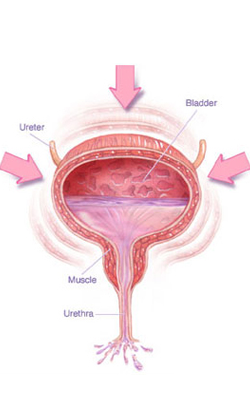
Overactive bladder or overactive bladder syndrome is a medical condition characterized by increased frequency of urination, episodes of inability to hold urine (urinary incontinence) which is characteristically preceded by excessive urge to pass urine, interrupted sleep at night due to increased urinary frequency etc.
Treatment
Usually combinations of different treatment options of overactive bladder are recommended based upon individual problems. These are
1. Behavioral interventions: these are first line treatment options. Although may not be able to cure the symptoms completely; these are quite beneficial along with other treatment options to reduce the frequency of urinary leakage (incontinence). These interventions include
a. Pelvic floor muscle exercise or Kegel exercise: this exercise helps in strengthening the muscles of the pelvic floor as well as the urinary sphincter muscles. Usually it takes 6 to 8 weeks before any improvement in the symptoms become evident.
b. Weight reduction in overweight or obese person: it might help to relieve the symptoms to some extent especially in people suffering from stress incontinence.
c. Restricted fluid intake especially in terms of amount and timing
d. Double voiding: people who have problem in completely emptying their bladder are benefitted from practicing double voiding. In double voiding after emptying the bladder once the affected person is advised to try to urinate again after waiting few minutes.
e. Scheduled trip to toilet: these people are advised to visit the toilet every 4 to 8 hours rather than waiting for the urge to urinate.
f. Intermittent catheterization: catheterization of the bladder at regular intervals helps to empty the bladder completely
g. Use of absorbent pad: as these are quite helpful in helping the affected person to get embarrassed due to involuntary urine leakage. These pads come in every size.
h. Bladder training: this characterized by training oneself so that one can delay urinating after feeling the urge by tightening the muscles of the pelvic floor.
2. Drugs: commonly sued drugs include tolterodine, oxybutynin, darifenacin, solifenacin etc. These drugs are anticholinergic agents hence the most common associated side effect is drying of mouth. But increased water intake to relieve the thirst may aggravate the symptoms of overactive bladder rendering the drug ineffective.
3. Botox injection: botulinum toxin or botox can be injected in the bladder to make the muscles paralyzed and can thus relieve the symptoms on temporary basis (for 6 to 9 months). This drug is not approved in patients with overactive bladder due to underlying neurological problems.
4. Stimulation of sacral nerves: controlling the nerve impulses supplying the bladder muscles may also improve the symptoms.
5. Surgery: surgical interventions are recommended only in people in whom all the other treatment measures fail to improve the symptoms. Recommended surgical interventions include
a. Surgery to increase the capacity of the bladder: in this case pieces of bowel tissue are used to replace a part of the bladder.
b. Removal of the bladder: this is the ultimate resort to manage the symptoms. In this procedure the bladder is removed and the urine is removed from the body through an opening on the skin (known as stoma) to which a bag is attached.





